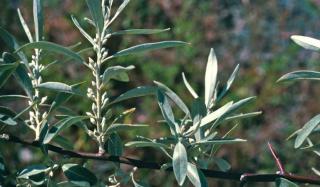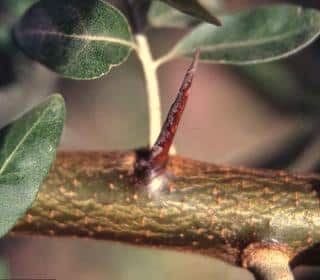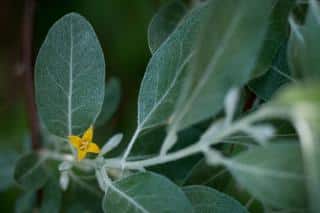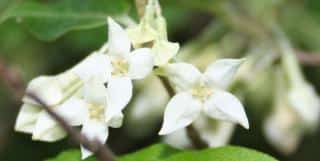

Russian olive is a stylish tree.
Russian olive key facts
Name – Elaeagnus angustifolia
Family – Elaeagnaceae
Type – shrub
Height – 6 to 13 feet (2 to 4 meters)
Exposure – full sun, part sun
Soil – ordinary
Foliage: deciduous – Flowering: May to June – Fruiting: August to October
Invasive in – United States, Canada
Its name comes from its native region – Southern Russia – and the resemblance to the olive tree around the Mediterranean. Ideal for hedges and very nice as standalones, these shrubs are easy to care for and very ornamental.
→ Note: Russian olive is an invasive species to control in some areas. Growing it is sometimes illegal according to some state and country regulations.
 Although best planted in fall, Russian olive trees cope perfectly with being planted all year round if they were purchased potted.
Although best planted in fall, Russian olive trees cope perfectly with being planted all year round if they were purchased potted.
If you plant your Russian olive trees during winter or during summer, avoid frost and freezing and heat waves, respectively.
To make a hedge, space trunks around 3 feet (1 meter) apart.
To increase the number of branches and make your shrubs or hedges more opaque, you can prune the shrubs lightly over the first few years, cutting back about ⅓ of the previous year’s growth.
 Russian olive can be pruned at the beginning of spring or in fall.
Russian olive can be pruned at the beginning of spring or in fall.
These shrubs grow back after all sorts of pruning, even if these were drastic.
They can thus be given different shapes, such as a big ball or other, without hindering their development.
Cutting Russian olive back severely (hard pruning it) sometimes triggers an unexpected response.
 Why does this happen? After cutting back most branches (sometimes called hat-racking), sap circulation is interrupted. The strong root system sends new shoots up in various places along the main roots, thus spreading the reach of the tree.
Why does this happen? After cutting back most branches (sometimes called hat-racking), sap circulation is interrupted. The strong root system sends new shoots up in various places along the main roots, thus spreading the reach of the tree.
This is typical of a root-suckering species, which Eleagnus angustifolia definitely is.
Foragers are keen on finding sources of food in the wild. Fruits of the Russian olive tree look like olives, hence the name. However, they aren’t very common as a source of food.
Nonetheless, they’re perfectly edible as long as a few conditions are met:
They’re edible raw, cooked, boiled or steamed and roasted.
 Being more hardy than classical olive trees and very beautiful with their silver-gold hues, Russian olive trees are making a comeback among the favorite plants in our gardens.
Being more hardy than classical olive trees and very beautiful with their silver-gold hues, Russian olive trees are making a comeback among the favorite plants in our gardens.
In spring, the discrete and delicate blooming will spread a fragrant bee-pleasing odor, and in fall yellow and silver-colored fruits attract birds with their fruits which are edible even for us. They stay attached to the tree even as leaves drop in Fall. A great winter snack for our fowl friends!
A cousin of Russian olive is American silverberry, Elaeagnus commutata. It’s native to North America, unlike Russian olive.
Elaeagnus don’t do well in very wet ground.
Avoid constantly waterlogged soil and stagnant water or your plant will dwindle away.
Russian Olive is an environmentally disruptive invasive species that degrades natural habitat for birds and creates unbalanced nitrogen fixing.
Quite a few states have laws against this tree and massive expenses on biological control.
Yes John, I appreciate your feed-back very much. I wrote an article up about the invasiveness of Russian olive and you can find it here.
This seems like an exceptionally irresponsible article!! I cannot believe you call these things “a nice shrub”!!! They wipe out other plants!!! They are impossible to get rid of!!! If you find them on your property in Colorado YOU ARE REQUIRED TO REMOVE THEM!!!
THEY ARE ABSOLUTELY HORRENDOUS PLANTS!!!!! They are a huge amount of work to get rid of. You have to dig out the extensive heavy root system and then pour high strength vinegar on any remaining, and then you have to watch for them to grow back, because they will!!! You will want to set fire to them because you are so desperate but fire does not work!!! These shrubs are the plant from hell!!!
Hi Rachael, you’re absolutely correct that this shrub is invasive in the United States. But for many readers in Europe, it’s perfectly allowed to plant this shrub in their garden. Plants that are invasive in some parts often have an important role to play in the places where they are native to. Knowing what is invasive and what isn’t for where you live is important, and it’s a blessing that you are very much aware of that for the State of Colorado! Congratulations for that! As a help to other people, I added yet another article explaining where is Russian olive native or invasive, on top of the one on how to control it. Tell me what you think!